Attached files
| file | filename |
|---|---|
| 8-K - ASTERIAS BIOTHERAPEUTICS, INC 8-K 10-12-2016 - Asterias Biotherapeutics, Inc. | form8k.htm |
Exhibit 99.1

Clinical-Stage Cell Therapy Programs Addressing Significant Unmet Medical Needs in Neurology and Oncology Asterias Biotherapeutics NYSE Market: ASTOctober 2016 14219863Text 04698Text 230237246Text
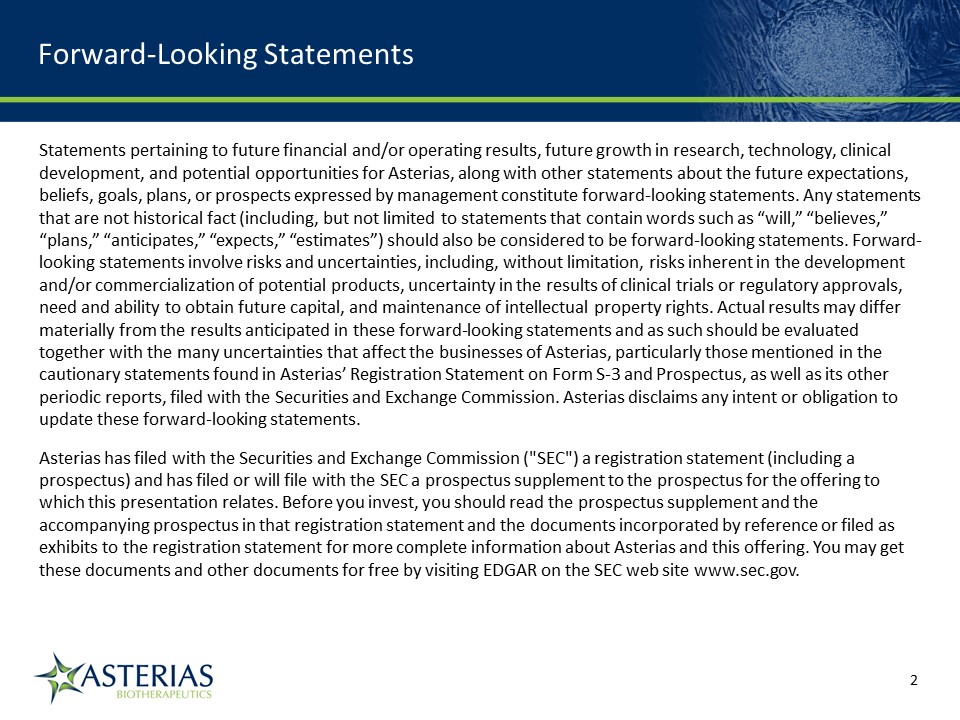
Statements pertaining to future financial and/or operating results, future growth in research, technology, clinical development, and potential opportunities for Asterias, along with other statements about the future expectations, beliefs, goals, plans, or prospects expressed by management constitute forward-looking statements. Any statements that are not historical fact (including, but not limited to statements that contain words such as “will,” “believes,” “plans,” “anticipates,” “expects,” “estimates”) should also be considered to be forward-looking statements. Forward-looking statements involve risks and uncertainties, including, without limitation, risks inherent in the development and/or commercialization of potential products, uncertainty in the results of clinical trials or regulatory approvals, need and ability to obtain future capital, and maintenance of intellectual property rights. Actual results may differ materially from the results anticipated in these forward-looking statements and as such should be evaluated together with the many uncertainties that affect the businesses of Asterias, particularly those mentioned in the cautionary statements found in Asterias’ Registration Statement on Form S-3 and Prospectus, as well as its other periodic reports, filed with the Securities and Exchange Commission. Asterias disclaims any intent or obligation to update these forward-looking statements.Asterias has filed with the Securities and Exchange Commission ("SEC") a registration statement (including a prospectus) and has filed or will file with the SEC a prospectus supplement to the prospectus for the offering to which this presentation relates. Before you invest, you should read the prospectus supplement and the accompanying prospectus in that registration statement and the documents incorporated by reference or filed as exhibits to the registration statement for more complete information about Asterias and this offering. You may get these documents and other documents for free by visiting EDGAR on the SEC web site www.sec.gov. Forward-Looking Statements

Strong Leadership Team with Proven Track Record Name Experience Steve CarttPresident and CEO Former COO of Questcor PharmaceuticalsLed Questcor’s 2007-2014 commercial strategy, turnaround and multiple expansionsGrew company revenue from $10 million to $1 billionOver 30 years of experience in pharma and biotech; at Questcor, Elan, ALZA Pharmaceuticals and ALZA Cor Don BaileyChairman of the Board Former CEO of Questcor Pharmaceuticals, led Questcor’s corporate turnaround Jane Lebkowski, Ph.D.CSO Former CSO of GeronOver 30 years experience in R&D of cell and gene therapies at Geron, Applied Immune Sciences, and Rhône Poulenc Rorer Katy Spink, Ph.D.COO Former SVP, Cell Therapy Program Operations at GeronPrior to Geron, Dr. Spink was a management consultant at McKinsey Ed Wirth, M.D., Ph.D.CMO Former CSO of InVivo Therapeutics25 years experience translational research at the University of Chicago, Geron and InVivo Ryan ChavezEVP Finance & GC Former General Counsel for Mallinckrodt ARD divisionAssociate General Counsel at Questcor; financial positions at GE During Mr. Cartt’s and Mr. Bailey’s seven year tenure, Questor’s stock price went from $0.35/share in August 2007 to the acquisition price of $93.58/share in 2014During this period, Questcor’s valuation increased over 200x, from $25 million to the company’s acquisition by Mallinckrodt for $5.8 billion 14219863Text 04698Text 230237246Text

Key Highlights AST-OPC1 (Pluripotent stem cell platform)Ongoing Phase 1/2a trial in spinal cord injury (SCI); supported by $14.3m grant from CIRMPositive safety profile to-date in two safety cohorts (thoracic SCI trial and cervical SCI trial) Emerging efficacy signal: early 2 & 10 million cell results to-date indicate efficacy and possible dose responseAST-VAC1 (Cancer Immunotherapy platform – autologous)Positive efficacy signal from open label Phase 2 study in AML (maintenance of remission)Planning confirmatory randomized/controlled phase 2b to initiate 2018Critical path: process development effort underway; completion expected Q3 2017AST-VAC2 (Cancer immunotherapy platform – allogeneic)Phase 1/2a trial in non-small cell lung cancer (NSCLC) planned to begin Q1 2017Trial fully funded by Cancer Research UK 14219863Text 04698Text 230237246Text

PROGRAM PRECLIN PHASE 1 PHASE 2 PHASE 3 STATUS AST-OPC1*Spinal Cord Injury (subacute) Ph 1/2a ongoing AST-VAC1**Leukemia (AML) Autologous Process development & enhancement in progress AST-VAC2**Lung Cancer Allogeneic Ph 1/2a planning for start Q1 2017 * Potential for application in advanced MS, stroke** Potential in multiple cancer types/stages as well as combination therapy Phase 1/2a in progress; positive early efficacy data presented 9/2016 Process development in progressPhase 2b to start early 2018 Phase 1/2a start Q1 2017 Development Pipeline 14219863Text 04698Text 230237246Text

Pluripotent stem cell platformSignificant grant funding from California Institute of Regenerative Medicine (CIRM)Phase 1/2a clinical trial in spinal cord injury in progress AST-OPC1 14219863Text 04698Text 230237246Text
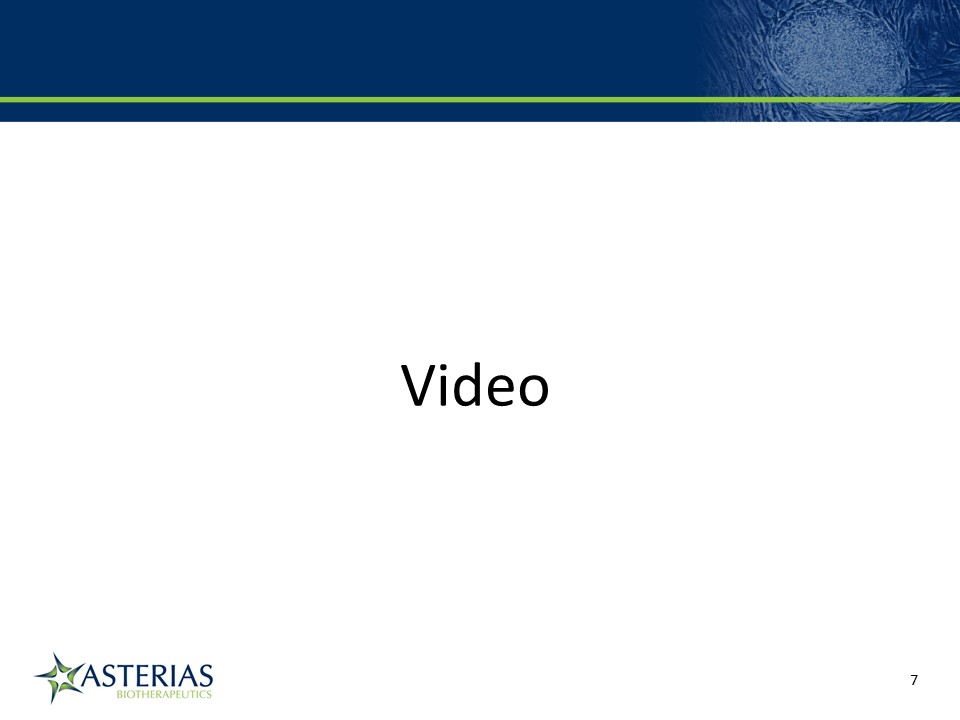
Video

Spinal Cord Injury: High Unmet Medical Need, Substantial Commercial Opportunity Spinal cord injury (SCI) affects 17,000 patients per year in U.S.(1)Primarily affects young/healthy males in their 20s and 30s at time of injuryCan be devastating to quality of life and ability to engage in activities of daily livingNo currently approved therapiesLifetime direct healthcare costs for a 25 year old patient can reach $5 million(1)Very high unemployment rate; 63% of cervical injury patients are unemployed even 8 years post-injurySignificant commercial opportunity exists in helping restore hand/arm/finger motor function, increasing independence and lessening daily healthcare burden(2) 14219863Text 04698Text 230237246Text (1) National Spinal Cord Injury Statistical Center, Facts and Figures 2016(2) Internal estimates
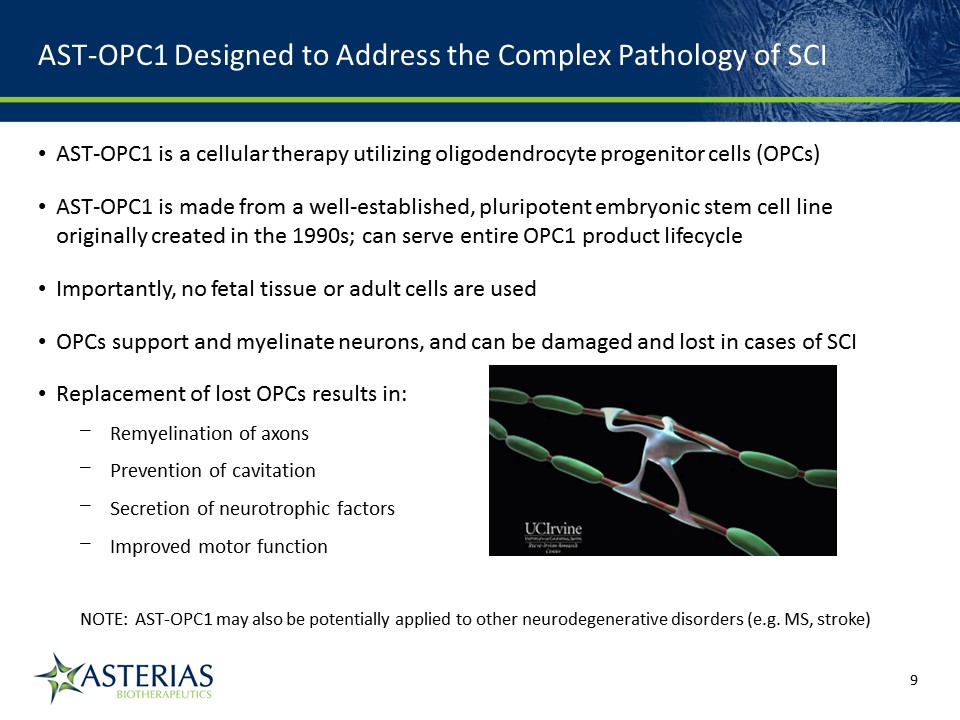
AST-OPC1 is a cellular therapy utilizing oligodendrocyte progenitor cells (OPCs) AST-OPC1 is made from a well-established, pluripotent embryonic stem cell line originally created in the 1990s; can serve entire OPC1 product lifecycleImportantly, no fetal tissue or adult cells are usedOPCs support and myelinate neurons, and can be damaged and lost in cases of SCIReplacement of lost OPCs results in:Remyelination of axonsPrevention of cavitationSecretion of neurotrophic factorsImproved motor functionNOTE: AST-OPC1 may also be potentially applied to other neurodegenerative disorders (e.g. MS, stroke) AST-OPC1 Designed to Address the Complex Pathology of SCI 14219863Text 04698Text 230237246Text
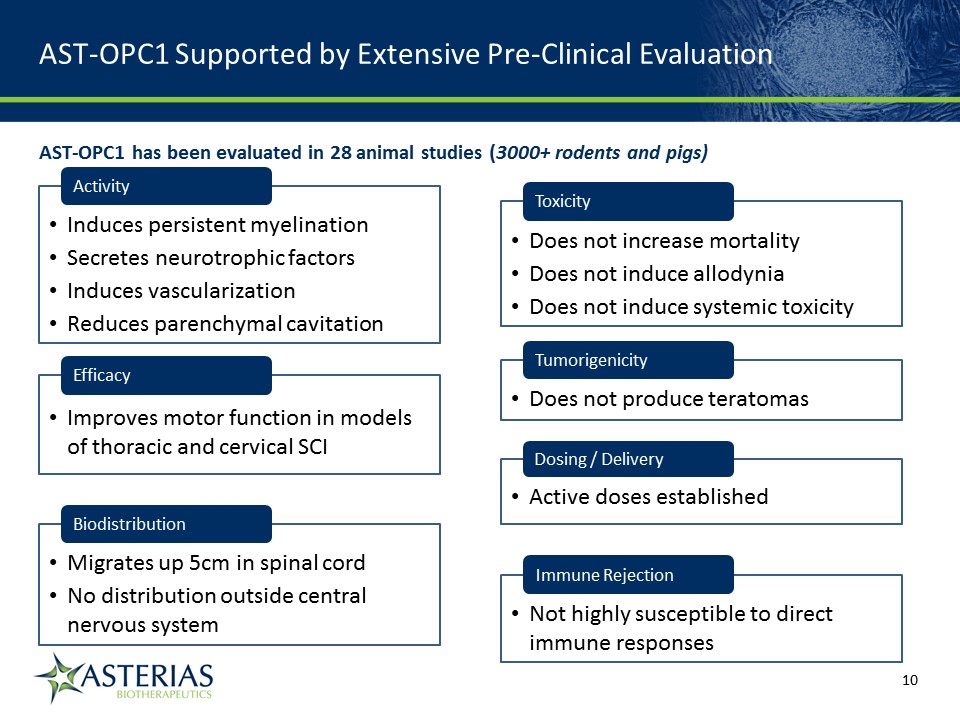
AST-OPC1 Supported by Extensive Pre-Clinical Evaluation 14219863Text 04698Text 230237246Text Activity Induces persistent myelinationSecretes neurotrophic factorsInduces vascularizationReduces parenchymal cavitation Biodistribution Migrates up 5cm in spinal cordNo distribution outside central nervous system Dosing / Delivery Active doses established Toxicity Does not increase mortalityDoes not induce allodyniaDoes not induce systemic toxicity Tumorigenicity Does not produce teratomas Immune Rejection Not highly susceptible to direct immune responses AST-OPC1 has been evaluated in 28 animal studies (3000+ rodents and pigs) Efficacy Improves motor function in models of thoracic and cervical SCI
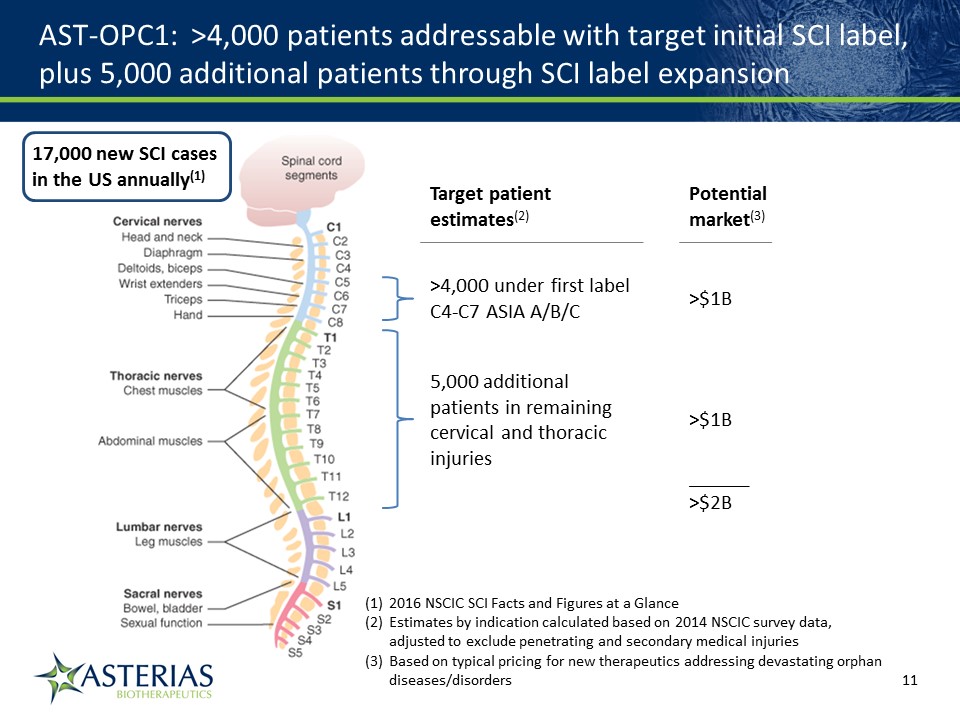
AST-OPC1: >4,000 patients addressable with target initial SCI label, plus 5,000 additional patients through SCI label expansion 17,000 new SCI cases in the US annually(1) >4,000 under first label C4-C7 ASIA A/B/C 2016 NSCIC SCI Facts and Figures at a GlanceEstimates by indication calculated based on 2014 NSCIC survey data, adjusted to exclude penetrating and secondary medical injuriesBased on typical pricing for new therapeutics addressing devastating orphan diseases/disorders 5,000 additional patients in remaining cervical and thoracic injuries >$1B >$1B Potential market(3) Target patient estimates(2) ______>$2B

Study DesignPhase 1/2a trial in progress (up to N=35)8-10 clinical sitesAIS-A and AIS-B patients2m, 10m, and 20m cell cohortsPrimary Assessment: SafetySecondary Assessment: ISNCSCI examMotor function assessment AST-OPC1 SCiSTAR Trial in Complete Cervical Spinal Cord Injury (SCI) Study GoalsAssess safety and efficacyEvaluate potential dose responseDetermine target patient population and optimal design for registration trial

Widely adopted tool for clinical assessment of neurological impairment after SCIMeasures changes in motor function, motor score, other key metricsTwo motor level improvement in the upper extremities is believed by experts to represent a clinically meaningful improvement in functioning, leading to significantly enhanced quality of life and ability to live independently21% and 26% of complete cervical SCI patients recover two motor levels spontaneously by 6 and 12 months, respectivelyInternational Standards for Neurological Classification of Spinal Cord Injury (ISNCSCI) ISNCSCI Exam is a Key Measurement Tool for SCI Recovery Steeves et al., Top Spinal Cord Inj Rehabil 2012; 18(1): 1-14

ISNCSCI Exam ISCoS ISNCSCI Algorithm

AST-OPC1 Therapy is Designed to Increase Patient Motor Function and Improve Quality of Life & Ability to Live Independently Capability C1-C3 C4 C5 C6 C7-C8 Bowel Bladder Bed Mobility Transfers Pressure Relief Eating Dressing Grooming Bathing Wheelchair Car Transport Daily Home Care 24 hr Attendant 18-24 hr Attendant 6-12 hr Assistance 4 hr Housework 1 hr Housework Total Assist Partial Assist Independent Steeves et al., Top Spinal Cord Inj Rehabil 2012; 18(1): 1-14 14219863Text 04698Text 230237246Text Trial success defined as ≥40-45% of treated patients regaining two or more motor levels of function; spontaneous recovery rate is 20-25% at 6-12 monthsThis degree of progress would translate into clinically significant improvements in ability to self-care and significant reductions in cost of care
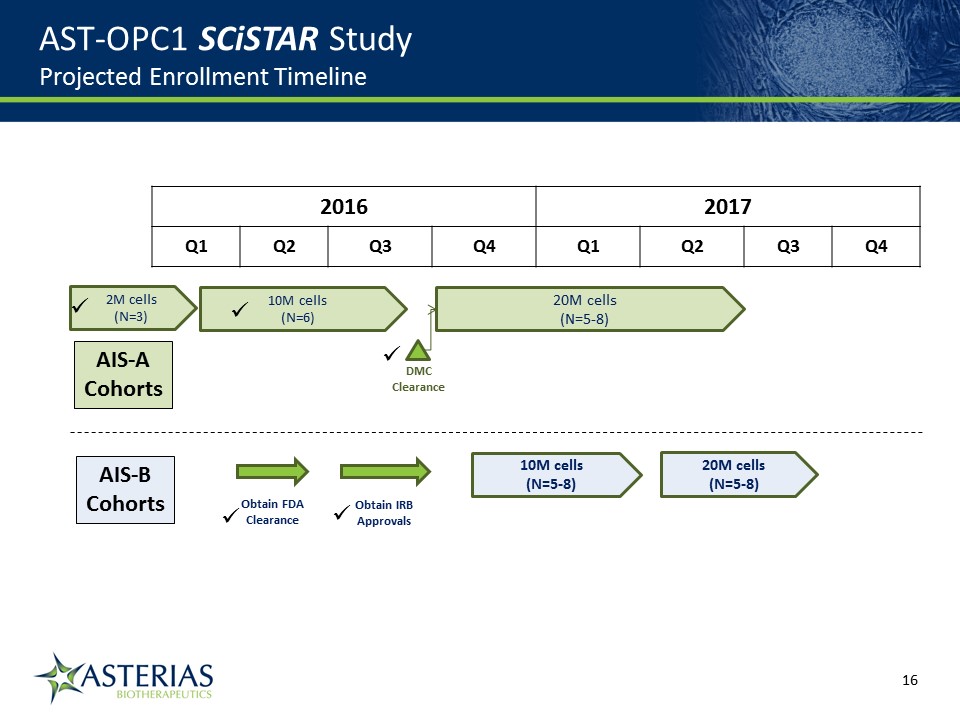
AST-OPC1 SCiSTAR StudyProjected Enrollment Timeline 14219863Text 04698Text 230237246Text 2016 2017 Q1 Q2 Q3 Q4 Q1 Q2 Q3 Q4 DMCClearance 10M cells(N=6) AIS-ACohorts AIS-BCohorts 20M cells(N=5-8) 10M cells(N=5-8) 20M cells(N=5-8) Obtain FDAClearance Obtain IRBApprovals 2M cells (N=3)

Upper Extremity Motor Recovery Observed in SCiSTAR Study (as of Sept 2016)By AST-OPC1 Dose Administered * N=4 at Day 90 (fifth subject has only reached Day 60) Average Upper Extremity Motor Score (UEMS) Change from Baseline Possible emerging dose response by Day 90: -patients dosed with 10 million cells: 9.5 average UEMS score improvement -patients dosed with 2 million cells: 5.0 average UEMS score improvement Days Post-Administration
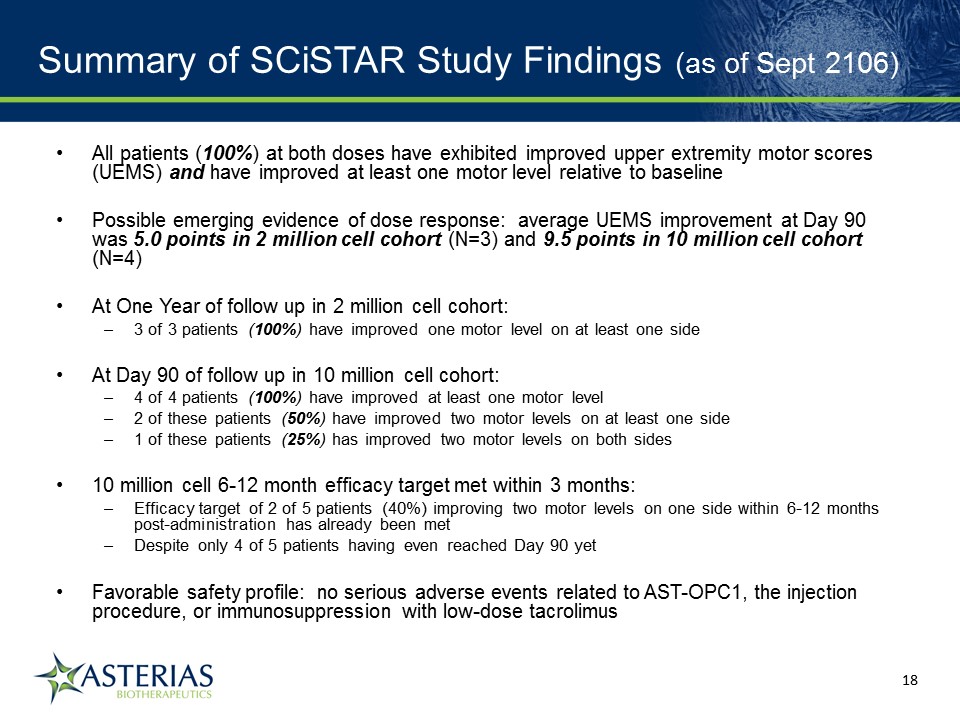
All patients (100%) at both doses have exhibited improved upper extremity motor scores (UEMS) and have improved at least one motor level relative to baselinePossible emerging evidence of dose response: average UEMS improvement at Day 90 was 5.0 points in 2 million cell cohort (N=3) and 9.5 points in 10 million cell cohort (N=4)At One Year of follow up in 2 million cell cohort:3 of 3 patients (100%) have improved one motor level on at least one sideAt Day 90 of follow up in 10 million cell cohort: 4 of 4 patients (100%) have improved at least one motor level2 of these patients (50%) have improved two motor levels on at least one side1 of these patients (25%) has improved two motor levels on both sides10 million cell 6-12 month efficacy target met within 3 months: Efficacy target of 2 of 5 patients (40%) improving two motor levels on one side within 6-12 months post-administration has already been metDespite only 4 of 5 patients having even reached Day 90 yetFavorable safety profile: no serious adverse events related to AST-OPC1, the injection procedure, or immunosuppression with low-dose tacrolimus Summary of SCiSTAR Study Findings (as of Sept 2106)

Milestone Est. Date 6 month data from AIS-A Cohort 2 (10M cells) January 2017 12 month data from AIS-A Cohort 2 (10M cells) July 2017 6 month data from AIS-B Cohort 1 (10M cells) Q3 2017 6 month data from AIS-A Cohort 3 (20M cells) Q4 2017 12 month data from AIS-B Cohort 1 (10M cells) Q1 2018 6 month data from AIS-B Cohort 2 (20M cells) Q1 2018 12 month data from AIS-A Cohort 3 (20M cells) Q2 2018 12 month data from AIS-B Cohort 2 (20M cells) Q3 2018 Final top-line efficacy data, all cohorts Q3 2018 Projected AST-OPC1 Data Milestones 14219863Text 04698Text 230237246Text NextData Readout
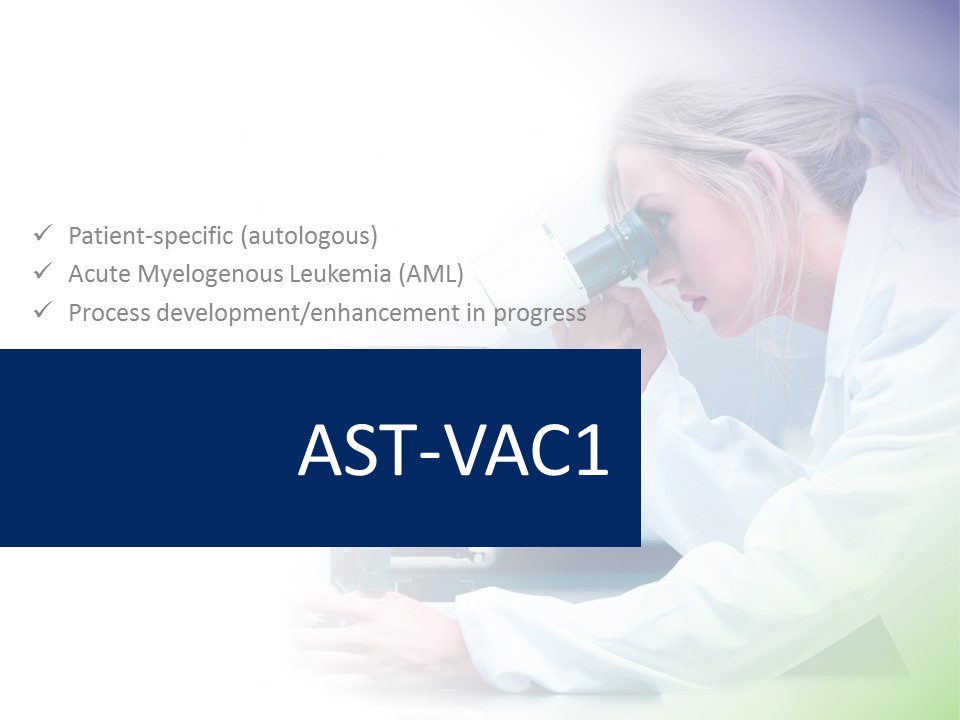
Patient-specific (autologous)Acute Myelogenous Leukemia (AML)Process development/enhancement in progress AST-VAC1 14219863Text 04698Text 230237246Text

AST-VAC1 is being developed as a treatment for maintenance of remission in AML patients >60 years and in high-risk patients (not eligible for bone marrow transplant)~19,000 new AML cases diagnosed and ~10,500 deaths from AML in U.S. annually(1)AML patients >60 years old do not tolerate AML therapies wellAverage age of an AML patient is 67 AST-VAC1 Targets AML Need in Older and High-Risk Patients 2014 estimate 14219863Text 04698Text 230237246Text

AST-VAC1 Has Potential to Safely Maintain AML Remission AML Two-Step Treatment Paradigm: Induction and Maintenance of Remission Step 1: InductionTraditional approach: chemotherapy to get patients into complete remissionMost new AML therapies also target Induction of Remission Step 2: Consolidation/MaintenanceChemotherapy and/or HCT to try to maintain remission long termCurrent treatments poorly tolerated by patients >60 years old AST-VAC1 is one of few new therapies targeting Maintenance of RemissionPotential alternative to consolidation chemotherapyLikely better safety and tolerability than chemotherapy or HCT 14219863Text 04698Text 230237246Text
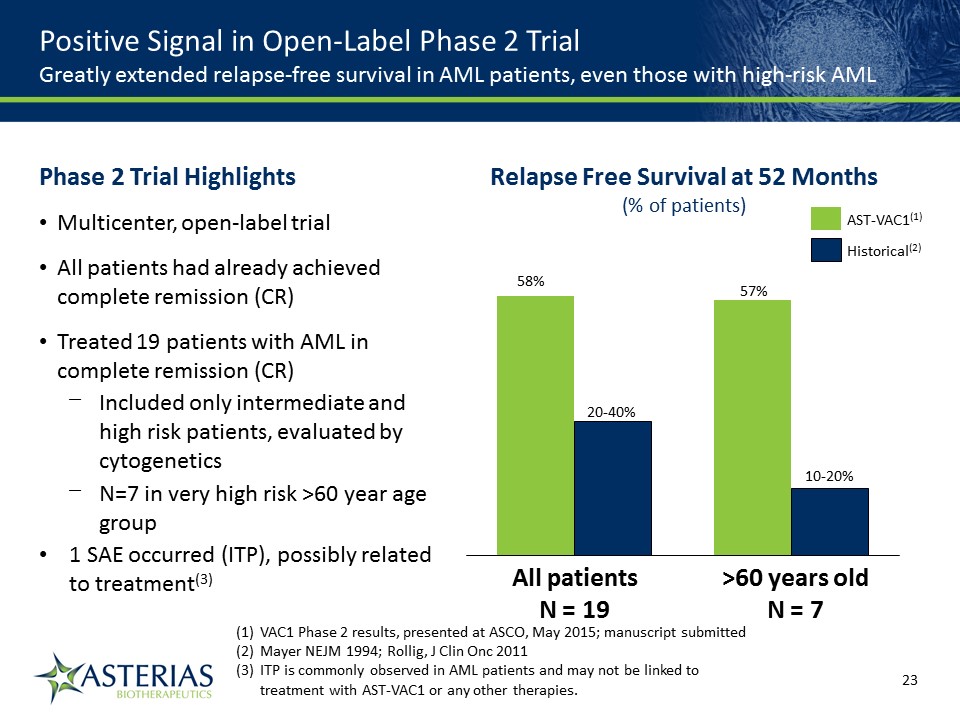
57% 10-20% >60 years oldN = 7 20-40% 58% All patientsN = 19 Relapse Free Survival at 52 Months(% of patients) Historical(2) AST-VAC1(1) VAC1 Phase 2 results, presented at ASCO, May 2015; manuscript submittedMayer NEJM 1994; Rollig, J Clin Onc 2011ITP is commonly observed in AML patients and may not be linked to treatment with AST-VAC1 or any other therapies. Positive Signal in Open-Label Phase 2 TrialGreatly extended relapse-free survival in AML patients, even those with high-risk AML Phase 2 Trial HighlightsMulticenter, open-label trialAll patients had already achieved complete remission (CR) Treated 19 patients with AML in complete remission (CR)Included only intermediate and high risk patients, evaluated by cytogeneticsN=7 in very high risk >60 year age group1 SAE occurred (ITP), possibly related to treatment(3) 14219863Text 04698Text 230237246Text
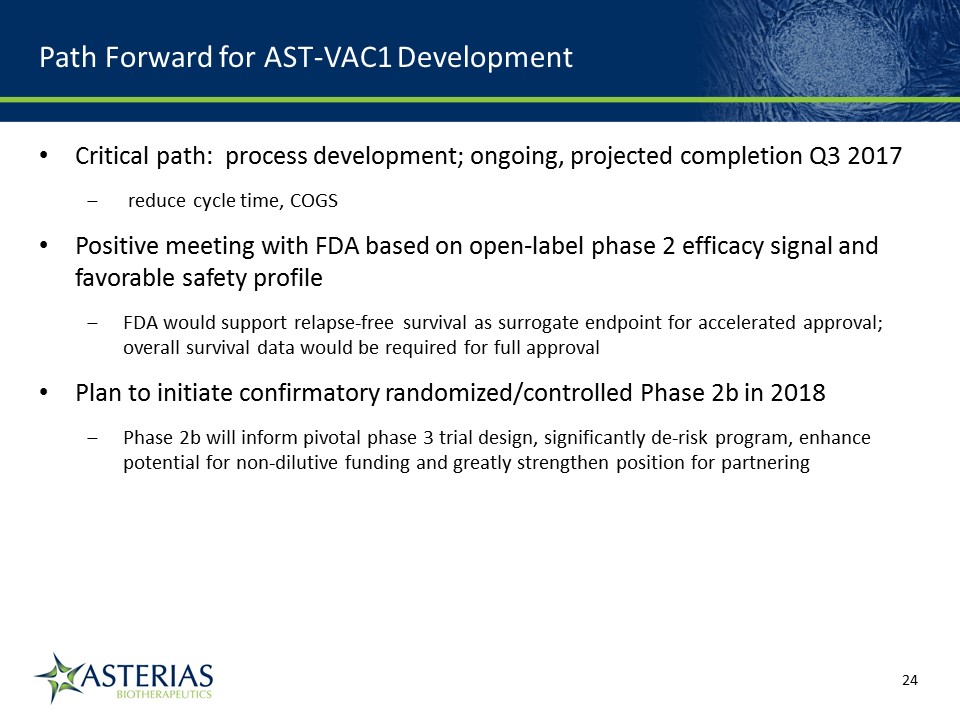
Path Forward for AST-VAC1 Development Critical path: process development; ongoing, projected completion Q3 2017 reduce cycle time, COGSPositive meeting with FDA based on open-label phase 2 efficacy signal and favorable safety profileFDA would support relapse-free survival as surrogate endpoint for accelerated approval; overall survival data would be required for full approvalPlan to initiate confirmatory randomized/controlled Phase 2b in 2018Phase 2b will inform pivotal phase 3 trial design, significantly de-risk program, enhance potential for non-dilutive funding and greatly strengthen position for partnering 14219863Text 04698Text 230237246Text

Non-patient specific (allogeneic), “ready-for-use”Non-small cell lung cancer (NSCLC)Development partnership with Cancer Research UKPhase 1/2a clinical trial sites open for enrollment Q1 2017 AST-VAC2 14219863Text 04698Text 230237246Text

AST-VAC2 Targets an Unmet Need in NSCLC, a Very Large Population of Cancer Patients with High Mortality Rate Not Staged3% Lung cancer is the most common type of cancer(1)Estimated 1.8M new cases and 1.6M lung cancer deaths worldwide in 2012~220,000 new cases and ~160,000 deaths annually in the U.S.80% of cases are non-small cell lung cancer (NSCLC)NSCLC has the highest death rate of any cancer(2)Overall 5-year survival rate for NSCLC is only 18%AST-VAC2 may also have applicability in other cancers (e.g. bladder, renal cell, melanoma), since telomerase expression is present in many cancer typesAST-VAC2 also has potential for use in combination with immune checkpoint inhibitors American Lung AssociationNCI SEER Cancer Statistics Review 14219863Text 04698Text 230237246Text

AST-VAC2 is Allogeneic, ‘Ready for Use,’ Non-Patient Specific AST-VAC2 cells are mature allogeneic dendritic cells that have been transfected with hTERT and LAMP(4,5)Not patient-specific: no need to produce individualized vaccines for each patientManufactured from Asterias embryonic stem cells, does not require patient’s own monocytesAST-VAC2 is ready to use on demand, greatly shortening the time to initiate treatmentProduct to be supplied from a single master cell bank, allowing scalability/consistencyThousands of patient treatments can be manufactured in a single batch 14219863Text 04698Text 230237246Text Centralized Production Facility Point of Care Distributed Frozen Inventory

Anticipate MHRA clearance for Phase 1/2a NSCLC trial early Q1 2017Clinical trial sites expected to be open for enrollment Q1 2017Partnership with Cancer Research UK (CRUK) funds full cost of GMP manufacturing, regulatory filing, and Phase 1/2a trialCRUK partnership saves Asterias an estimated ~$30MFollowing a successful Phase 1/2a trial, Asterias can continue development in exchange for modest milestones and royalties to CRUK Phase 1/2a Trial to be Funded Through CRUK Partnership 14219863Text 04698Text 230237246Text
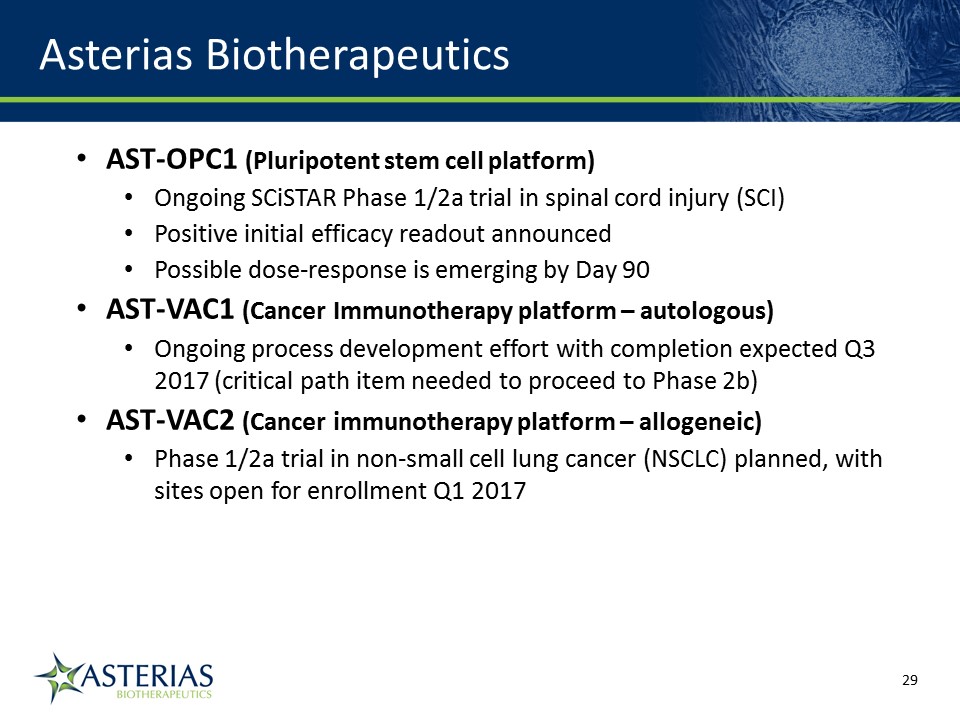
Asterias Biotherapeutics AST-OPC1 (Pluripotent stem cell platform)Ongoing SCiSTAR Phase 1/2a trial in spinal cord injury (SCI)Positive initial efficacy readout announcedPossible dose-response is emerging by Day 90AST-VAC1 (Cancer Immunotherapy platform – autologous)Ongoing process development effort with completion expected Q3 2017 (critical path item needed to proceed to Phase 2b)AST-VAC2 (Cancer immunotherapy platform – allogeneic)Phase 1/2a trial in non-small cell lung cancer (NSCLC) planned, with sites open for enrollment Q1 2017 14219863Text 04698Text 230237246Text
